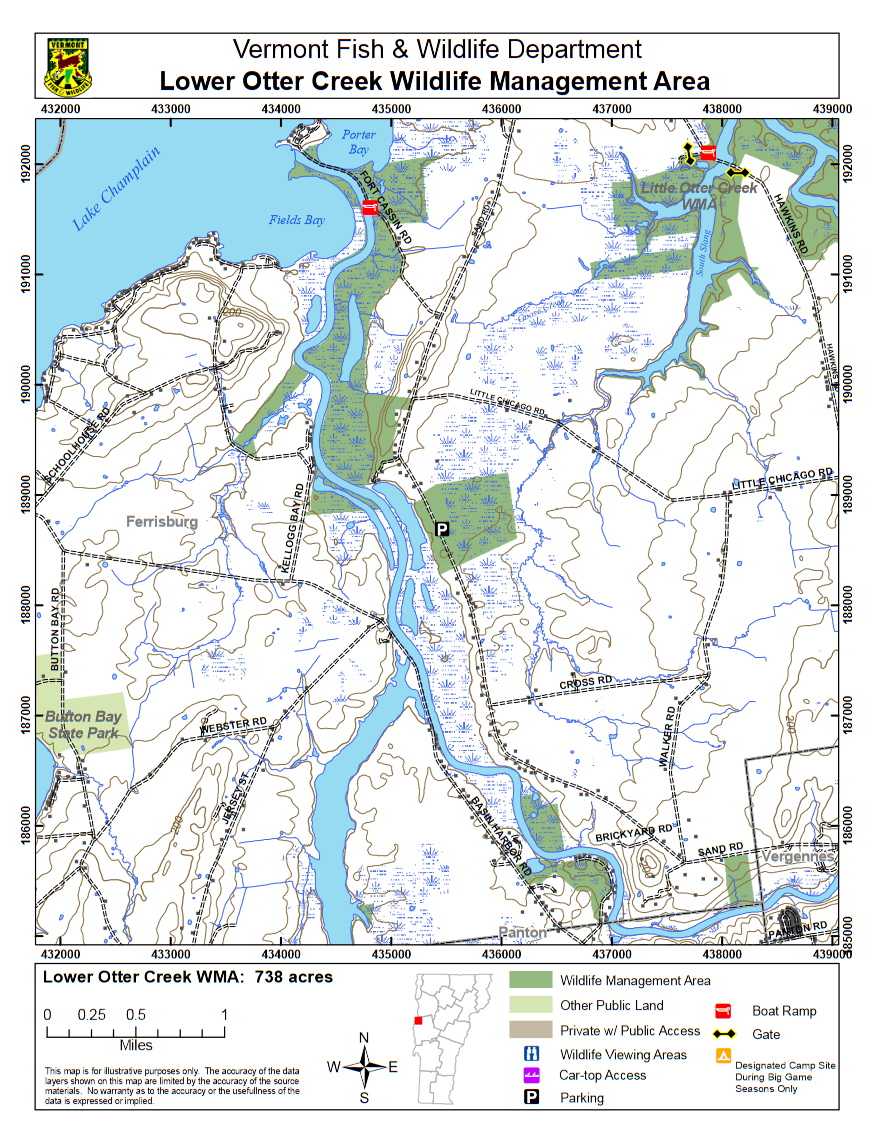Lower Otter Creek WMA
Lower Otter Creek WMA
Ferrisburgh, Vermont 05456
Lower Otter Creek Wildlife Management Area guide and mapBirds of Interest
Birds of Interest All manner of wetland and water birds are attracted to the Lower Otter Creek Wildlife Management Area with its protected waters and marshes. Ring-billed and great black-backed gulls and double-crested cormorants forage here. There’s a great blue heron rookery in Porter Bay with approximately 100 nests. Marsh birds, including the elusive least bittern, hide in the cattails and buttonbush. Mallards, hooded mergansers, wood, and black ducks, and blue-winged teal are breeding ducks that live in the marsh. Other ducks pass through during migration. There are also a variety of songbirds such as Baltimore orioles, eastern kingbirds, thrushes, and several warbler species. As mentioned, ospreys breed here and bald eagles are known to frequent the area. Eagles are commonly seen in Kellogg’s Bay during the ice-fishing season.
About this Location
Lower Otter Creek Wildlife Management Area (WMA) includes 738 acres of wetland and floodplain forest near the mouth of Otter Creek in Ferrisburg, Vermont. Boat access is via the Creek or Lake Champlain. There is a State boat access on Fort Cassin Road. Otter Creek is navigable by motorboat for several miles, as far as the falls in Vergennes. There is walk-in access for the parcel bordering Sand Road. The WMA is owned by the State of Vermont and managed by the Vermont Fish and Wildlife Department.
From remains along Otter Creek, it is evident that the Archaic Indians hunted small game, collected nuts, berries, and roots, and fished in this area. Later there were permanent Abenaki, and possibly Iroquois, summer settlements along Otter Creek and the shores of Lake Champlain, where they hunted, fished, and grew crops. These people moved to the mountains during the winter months to hunt.
When Europeans settled, they also occupied the lakeshore and riverbanks. During Revolutionary times, Fort Cassin was built on Cassin Point at the mouth of Otter Creek. It was meant to defend the temporary shipyard at Vergennes. It was attacked once by the British in 1814. There is no longer any sign of it. There are also the remains of a canal that was dug to avoid the British fleet during the Revolutionary War. Today that passage is known as the “dugout.” Another historic relic is the towpath along the east side of the river, which is evidence of the thriving commercial community in colonial Vergennes.
The land surrounding the Otter Creek wetlands has been used for farming for a long time, both by Native Americans and European settlers and their descendants. The Lake Champlain shoreline in this area is dotted with summer homes and has become a popular recreation area.
The first State acquisition was in 1956, using Pittman-Robertson funds. These funds are generated from the sale of firearms and ammunition. There have been several subsequent acquisitions, some of which were made using funds from the North American Wetland Conservation Act, State Duck Stamp Fund, and Ducks Unlimited. Several of these acquisitions were made with the assistance of The Nature Conservancy.
Otter Creek has formed a delta at its mouth that reaches out into Lake Champlain. North of the delta is the protected Porter Bay (also known as Flat Rock Bay). South of the point is a more open bay called Fields or Kellogg’s Bay. There is an oxbow farther upstream called Porter Lake, which is excellent duck breeding habitat.
Otter Creek’s delta is covered mostly with silver maple-green ash swamp but the WMA also supports silver maple-sensitive fern riverine floodplain forest. Other tree species found on the WMA are hemlock, American elm, black ash, white, swamp white, and red oak. Wetlands occur upstream from the mouth and in the corners of Porter Bay. These wetlands support a deep bullrush marsh component, cattail marsh, and buttonbush shrub swamp. The WMA also has a small old-field component.
Arrowleaf, narrow blue-eyed grass, marsh vetchling, lance-leaved loosestrife, water hemp, cat-tail sedge, yellow pimpernel, foxtail sedge, yellow water-crowfoot, green dragon, and folliculate sedge are rare plants that have been found in the WMA.
State-endangered ospreys nest in the WMA, both on manmade platforms and in trees. Bald eagles are often seen here, especially in winter. Two types of mussels, the pink heelsplitter, and the state-endangered fragile papershell have been found in Otter Creek. All threatened and endangered wildlife is protected by law and should not be disturbed.
Features
Restrooms on site
Wheelchair accessible trail
Entrance fee
Content from Lower Otter Creek Wildlife Management Area guide and map
Last updated December 3, 2023
